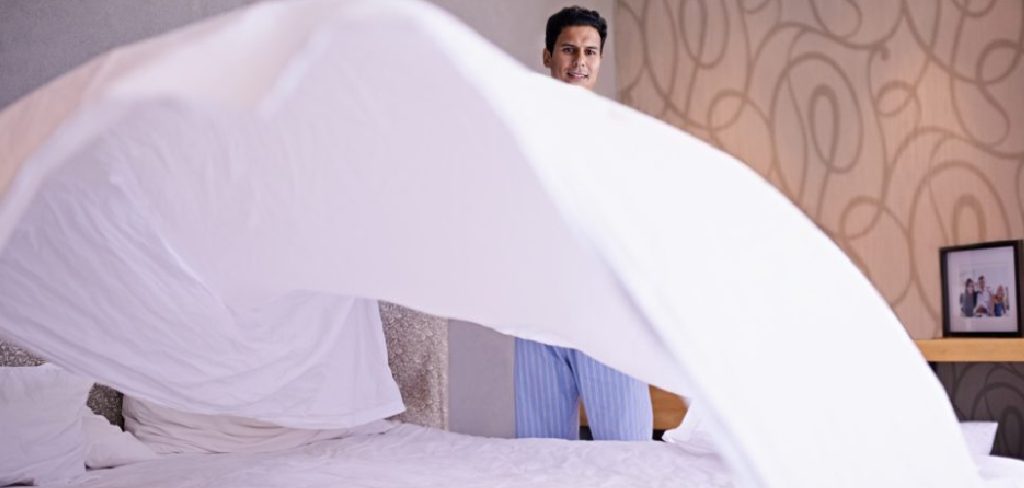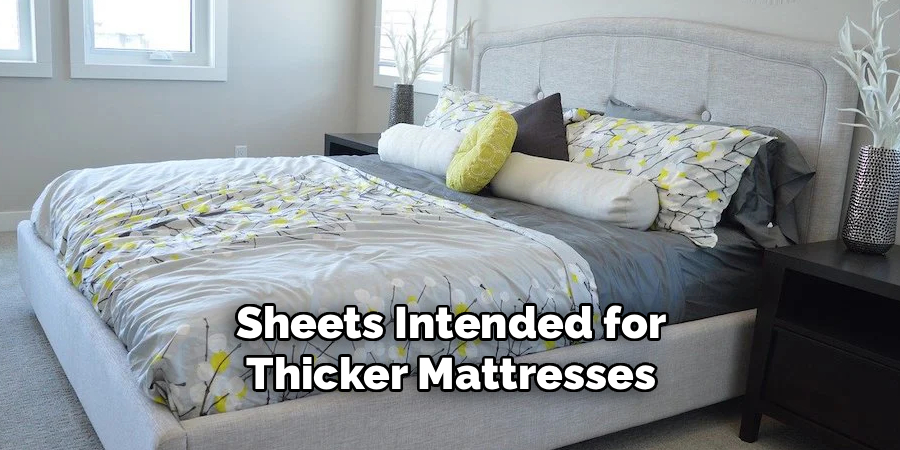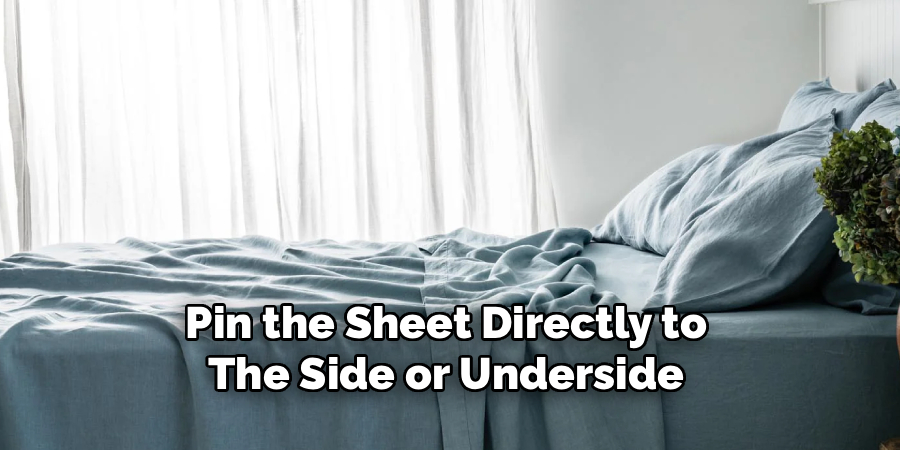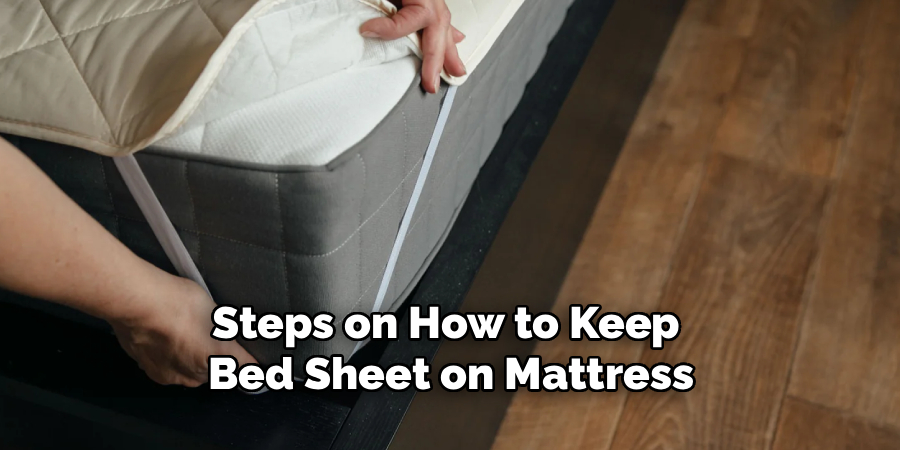A well-made bed is more than just a visual pleasure; it’s a cornerstone of a restful night’s sleep. However, this peaceful image can be quickly disrupted by a common annoyance: bed sheets that refuse to stay in place. Waking up tangled in loose fabric or finding your fitted sheet has pinged off a corner of the mattress is frustrating and can interrupt your sleep cycle.
Securing your bed sheets is about creating a stable, comfortable, and inviting sleep environment. A taut, smooth sheet prevents wrinkles and bunching, which can be uncomfortable against your skin. This guide on how to keep bed sheet on mattress will walk you through simple yet effective methods to ensure your sheets remain exactly where they belong, all night long.

Tools and Materials You’ll Need
- Fitted sheets with deep pockets
- Flat sheet
- Sheet straps or suspenders (elastic straps with clips)
- Safety pins (large and rust-proof)
- Rug corners or non-slip mattress grips
- Layered bedding (mattress protector, topper)
- Textured blanket or coverlet (optional)
8 Simple Step-by-step Guidelines on How to Keep Bed Sheet on Mattress
Step 1: Choose the Right Size and Type of Sheets
The foundation of a secure bed is using sheets that are correctly sized for your mattress. A common mistake is using sheets with pockets that are too shallow for the mattress’s depth, especially with modern pillow-top or deep mattresses. Measure the depth of your mattress, including any toppers, and purchase fitted sheets with pockets that are at least one to two inches deeper. This extra fabric allows the elastic to tuck securely underneath the mattress, providing a much stronger hold and preventing the corners from slipping off when you move.
Beyond just the pocket depth, consider the material and quality of the sheets. High-quality sheets made from materials like long-staple cotton or linen often have a better structure and more robust elastic than cheaper alternatives. Some brands specifically design “deep pocket” sheets intended for thicker mattresses. Investing in the right size from the start can solve the problem before it even begins, eliminating the need for extra gadgets and adjustments. Always check the packaging for mattress depth recommendations to ensure a perfect fit.

Step 2: Use Sheet Straps or Suspenders
For those who need an extra layer of security, sheet straps, also known as suspenders or fasteners, are an incredibly effective solution. These accessories are essentially elastic straps with clips on each end that are designed to hold the corners of your fitted sheet firmly in place. They work by creating tension from underneath the mattress, pulling the sheet taut and preventing it from riding up. You can find them in various designs, including simple two-clip straps for each corner or a crisscross design that connects diagonally from one corner to the other for maximum hold.
To use them, first, fit your sheet onto the mattress as you normally would. Then, lift one corner of the mattress slightly and attach one clip of the strap to the edge of the sheet. Stretch the strap underneath the corner and attach the other clip to the adjacent side of the sheet, about one or two feet away from the corner. Repeat this process for all four corners. The added tension makes it nearly impossible for the sheet to come loose, even for the most restless sleepers. This simple tool is a game-changer for keeping your bed neat and tidy.

Step 3: Try Layering Your Bedding Strategically
Creating friction between the layers of your bedding can significantly reduce sheet slippage. A bare mattress, especially one with a silky or smooth surface, provides little for your fitted sheet to grip onto. By adding a textured layer between your mattress and your sheet, you can create the resistance needed to hold everything in place. A mattress protector or a fitted mattress pad, particularly one made from cotton or a textured material, is an excellent first layer. This not only protects your mattress but also provides a non-slip base for your fitted sheet.
You can take this layering technique a step further by adding a thin, textured blanket or a cotton coverlet directly on top of the mattress protector before putting on the fitted sheet. The added texture provides even more grip, anchoring the sheet from below. This method works by disrupting the smooth, slippery surface-on-surface contact that allows sheets to slide around. It’s a simple, invisible trick that uses the bedding you likely already own to create a much more stable and secure foundation for a perfectly made bed.
Step 4: Master the Art of Hospital Corners
The hospital corner technique is a time-tested method used by hotels and military personnel to keep flat sheets incredibly neat and secure. While it is traditionally used for the top flat sheet, a modified version can be applied to keep an oversized flat sheet in place as a bottom sheet. This method creates a clean, tight finish that is difficult to undo with tossing and turning. It’s particularly useful if you prefer using a flat sheet instead of a fitted one, or if your fitted sheet is just not cooperating.
To create a hospital corner, lay your flat sheet over the mattress and tuck it in along the foot of the bed. Move to one of the bottom corners and pick up the edge of the sheet to create a 45-degree angle with the corner of the mattress. Lay the triangular flap of fabric you’ve created onto the top of the mattress. Next, neatly tuck the hanging portion of the sheet underneath the mattress along the side. Finally, pull the triangular flap down and tuck it tightly under the mattress as well. Repeat on the other side for a perfectly crisp, secure bed.

Step 5: Utilize Non-Slip Mattress Grips
If you find that your entire fitted sheet, and not just the corners, tends to slide around on the mattress surface, non-slip mattress grips or rug corners can be an excellent solution. These products are designed to create friction and are typically made from a rubbery, grippy material. Originally intended to keep area rugs from sliding on hardwood floors, they work just as effectively under a bed sheet. You can purchase specialized non-slip mattress pads or simply use a few pieces of a non-slip rug pad.
To implement this method, place a non-slip pad or several grip corners directly on the surface of your mattress before you put on your fitted sheet. Position them in the areas where slipping is most common, such as near the corners and along the sides of the bed. When you put the fitted sheet over them, the grippy material will hold the fabric in place, preventing it from shifting as you move during the night. This is an especially helpful trick for slick memory foam or latex mattresses that offer very little natural friction.
Step 6: Secure with Large Safety Pins
For a simple and cost-effective DIY solution, large safety pins can be used to manually anchor your fitted sheet to the mattress. This method gives you complete control over securing any problem areas, ensuring the sheet is pinned down exactly where it’s needed most. It’s crucial to use large, heavy-duty safety pins that are rust-proof to avoid damaging your sheets or mattress over time. Smaller pins may not be strong enough to hold the fabric under tension or could potentially pop open.
After putting your fitted sheet on, identify the spots where it tends to slip. Lift the edge of your mattress slightly and pin the sheet directly to the side or underside of the mattress itself. Be sure to catch enough of the mattress fabric to create a strong anchor point. You can place a pin every couple of feet along the sides of the bed and add extra pins at the corners for reinforced security. While effective, this method requires a bit of care to ensure the pins go through the mattress fabric and not just the surface quilting.

Step 7: Invest in Sheets with Two-Way Stretch
Innovations in bedding have led to the creation of sheets designed specifically to combat slipping. Some brands offer sheets made from materials with a two-way or four-way stretch, similar to athletic apparel. These fabrics, often a blend of cotton with spandex or another elastic material, are designed to hug the mattress securely. The inherent stretchiness of the material allows it to conform perfectly to the shape of your mattress and stay in place, even with significant movement throughout the night.
These stretchy sheets offer a significant advantage over traditional woven cotton sheets, which have very little give. The elastic properties mean they can accommodate a wider range of mattress depths without becoming loose. They pull taut naturally, creating a smooth, wrinkle-free surface that feels great to sleep on. While they may come at a slightly higher price point, investing in a set of high-performance stretchy sheets can permanently solve your slipping sheet problem with zero extra effort or accessories required.
Step 8: Consider a Zippered Sheet System
For the ultimate solution in sheet security, a zippered sheet system is unbeatable. This design completely eliminates the possibility of sheets coming undone. These systems typically feature a base that zips onto and encases the entire mattress, similar to a mattress protector. The top flat sheet is then zipped directly onto this base. When it’s time to do laundry, you simply unzip the top sheet, wash it, and zip a clean one back on. This is not only incredibly secure but also makes changing the bed a much faster and easier task.
This type of bedding is particularly popular for children’s beds, bunk beds, and RVs, where making the bed can be awkward and difficult. However, it’s also an excellent choice for any restless sleeper who is tired of constantly fighting with their bedding. By physically attaching the sheet to the mattress base, there is no way for it to bunch up, pull free, or slip off the corners. A zippered system guarantees a perfectly neat bed every single morning, providing peace of mind and a consistently comfortable sleep surface.
Regular Maintenance Check
To ensure your sheets continue to fit well over time, regular maintenance is key. When you wash your sheets, avoid using excessively high heat in the dryer, as this can damage and weaken the elastic in your fitted sheet, causing it to lose its stretch and grip. Check the elastic periodically for signs of wear and tear. Additionally, rotate your mattress every three to six months. This not only promotes even wear on the mattress but can also help resettle the foundation, which may affect how your sheets fit. Finally, ensure any mattress toppers or pads are smooth and properly aligned before making the bed, as lumps underneath can cause the sheet to shift.
Following these steps on how to keep bed sheet on mattress, you can ensure a snug and comfortable fit for your sheets every time. Moreover, taking care of your mattress and bedding will not only prolong their lifespan but also improve the quality of your sleep.

Frequently Asked Questions
Q1: Why Do My Bed Sheets Keep Slipping?
A1: Bed sheets typically slip for a few common reasons. The most frequent cause is an improper fit; the fitted sheet’s pockets may be too shallow for your mattress’s depth, especially if you use a mattress topper. Another reason is the lack of friction between the sheet and the mattress, which is common with silky mattress surfaces or sateen-weave sheets. Finally, restless sleeping habits can naturally pull and tug on sheets, causing them to come loose over the course of the night.
Q2: Can the Material of the Sheets Affect Slippage?
A2: Absolutely. The material and weave of your sheets play a significant role. Silky, smooth fabrics like sateen or silk have less natural grip and are more prone to sliding on the mattress surface. In contrast, materials with more texture, such as flannel, linen, or percale cotton, tend to stay in place better. Sheets that incorporate a bit of spandex or another elastic fiber are specifically designed to stretch and cling to the mattress, offering superior slip resistance.
Q3: Are Deeper Pockets on a Fitted Sheet Always Better?
A3: Deeper pockets are generally better, but only if they are the correct size for your mattress. The goal is to have pockets that are about two to three inches deeper than your mattress’s total height (including any toppers). This allows the elastic edge to tuck securely under the mattress. However, if the pockets are excessively deep for a thin mattress, you may end up with extra fabric that can bunch up underneath, so finding that “just right” fit is key.
Q4: How Can I Stop My Top Sheet From Coming Untucked?
A4: To keep your top flat sheet secure, the hospital corner technique is your best bet. By tucking the sheet in at the foot of the bed and then creating a tight, folded corner on each side, you create a very secure anchor that is difficult to pull out. Another method is to leave more fabric at the foot of the bed when you initially place it, allowing for a deeper tuck. You can also use sheet straps on the bottom corners of your top sheet, clipping them to the underside of your mattress.

Conclusion
Achieving a perfectly made bed where the sheets stay put is not an impossible dream. By starting with the right-sized sheets and understanding the dynamics of fit and friction, you can put an end to the nightly struggle with rogue bedding. Whether you choose a simple solution like mastering hospital corners or invest in innovative tools like sheet straps or zippered systems, these methods empower you to create a secure and comfortable sleep sanctuary.
Following these guidelines on how to keep bed sheet on mattress will not only keep your bed looking neat and inviting but will also contribute to a more restful and uninterrupted night’s sleep.
About
Construct Fixes is a distinguished figure in the world of Diy design, with a decade of expertise creating innovative and sustainable Diy solutions.
His professional focus lies in merging traditional craftsmanship with modern manufacturing techniques,
fostering designs that are both practical and environmentally conscious. As the author of diy,
constructfixes delves into the art and science of construction-making, inspiring artisans and industry professionals alike.
Education RMIT University
(Melbourne, Australia) Associate Degree in Design (Construct Fixes) Focus on sustainable design, industry-driven projects,
and practical craftsmanship. Gained hands-on experience with traditional and digital manufacturing tools, such as CAD and CNC software.
Nottingham Trent University
(United Kingdom) Bachelor’s in constructfixes.com and Product Design (Honors) Specialized in product design with a focus on blending creativity with production
techniques. Participated in industry projects, working with companies like John Lewis and Vitsoe to gain real-world insights.
Publications and Impact
In diy, Construct Fixes his insights on indoor design processes, materials, and strategies for efficient production.
His writing bridges the gap between artisan knowledge and modern industry needs, making it a must-read for both budding designers and seasoned professionals.
